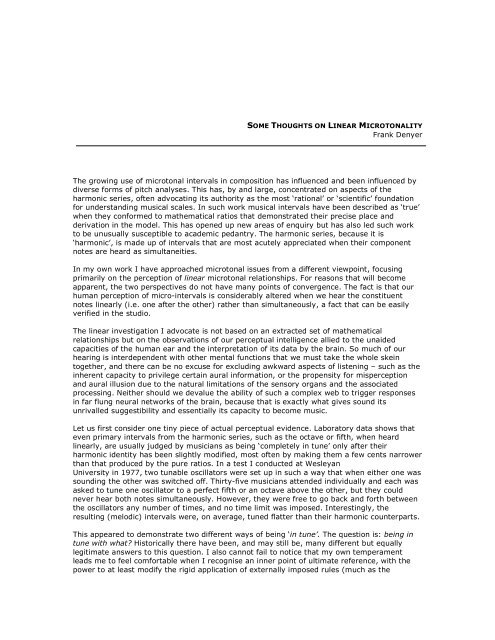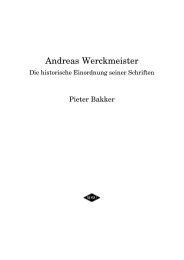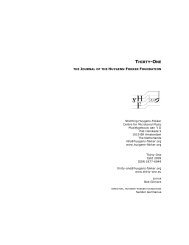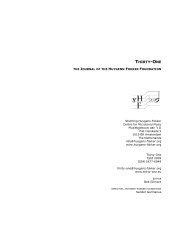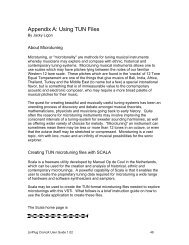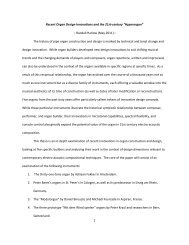Some Thoughts on Linear Microtonality - Frank Denyer - Stichting ...
Some Thoughts on Linear Microtonality - Frank Denyer - Stichting ...
Some Thoughts on Linear Microtonality - Frank Denyer - Stichting ...
Create successful ePaper yourself
Turn your PDF publications into a flip-book with our unique Google optimized e-Paper software.
SOME THOUGHTS ON LINEAR MICROTONALITY<strong>Frank</strong> <strong>Denyer</strong>The growing use of microt<strong>on</strong>al intervals in compositi<strong>on</strong> has influenced and been influenced bydiverse forms of pitch analyses. This has, by and large, c<strong>on</strong>centrated <strong>on</strong> aspects of theharm<strong>on</strong>ic series, often advocating its authority as the most ‘rati<strong>on</strong>al’ or ‘scientific’ foundati<strong>on</strong>for understanding musical scales. In such work musical intervals have been described as ‘true’when they c<strong>on</strong>formed to mathematical ratios that dem<strong>on</strong>strated their precise place andderivati<strong>on</strong> in the model. This has opened up new areas of enquiry but has also led such workto be unusually susceptible to academic pedantry. The harm<strong>on</strong>ic series, because it is‘harm<strong>on</strong>ic’, is made up of intervals that are most acutely appreciated when their comp<strong>on</strong>entnotes are heard as simultaneities.In my own work I have approached microt<strong>on</strong>al issues from a different viewpoint, focusingprimarily <strong>on</strong> the percepti<strong>on</strong> of linear microt<strong>on</strong>al relati<strong>on</strong>ships. For reas<strong>on</strong>s that will becomeapparent, the two perspectives do not have many points of c<strong>on</strong>vergence. The fact is that ourhuman percepti<strong>on</strong> of micro-intervals is c<strong>on</strong>siderably altered when we hear the c<strong>on</strong>stituentnotes linearly (i.e. <strong>on</strong>e after the other) rather than simultaneously, a fact that can be easilyverified in the studio.The linear investigati<strong>on</strong> I advocate is not based <strong>on</strong> an extracted set of mathematicalrelati<strong>on</strong>ships but <strong>on</strong> the observati<strong>on</strong>s of our perceptual intelligence allied to the unaidedcapacities of the human ear and the interpretati<strong>on</strong> of its data by the brain. So much of ourhearing is interdependent with other mental functi<strong>on</strong>s that we must take the whole skeintogether, and there can be no excuse for excluding awkward aspects of listening – such as theinherent capacity to privilege certain aural informati<strong>on</strong>, or the propensity for mispercepti<strong>on</strong>and aural illusi<strong>on</strong> due to the natural limitati<strong>on</strong>s of the sensory organs and the associatedprocessing. Neither should we devalue the ability of such a complex web to trigger resp<strong>on</strong>sesin far flung neural networks of the brain, because that is exactly what gives sound itsunrivalled suggestibility and essentially its capacity to become music.Let us first c<strong>on</strong>sider <strong>on</strong>e tiny piece of actual perceptual evidence. Laboratory data shows thateven primary intervals from the harm<strong>on</strong>ic series, such as the octave or fifth, when heardlinearly, are usually judged by musicians as being ‘completely in tune’ <strong>on</strong>ly after theirharm<strong>on</strong>ic identity has been slightly modified, most often by making them a few cents narrowerthan that produced by the pure ratios. In a test I c<strong>on</strong>ducted at WesleyanUniversity in 1977, two tunable oscillators were set up in such a way that when either <strong>on</strong>e wassounding the other was switched off. Thirty-five musicians attended individually and each wasasked to tune <strong>on</strong>e oscillator to a perfect fifth or an octave above the other, but they couldnever hear both notes simultaneously. However, they were free to go back and forth betweenthe oscillators any number of times, and no time limit was imposed. Interestingly, theresulting (melodic) intervals were, <strong>on</strong> average, tuned flatter than their harm<strong>on</strong>ic counterparts.This appeared to dem<strong>on</strong>strate two different ways of being ‘in tune’. The questi<strong>on</strong> is: being intune with what? Historically there have been, and may still be, many different but equallylegitimate answers to this questi<strong>on</strong>. I also cannot fail to notice that my own temperamentleads me to feel comfortable when I recognise an inner point of ultimate reference, with thepower to at least modify the rigid applicati<strong>on</strong> of externally imposed rules (much as the


